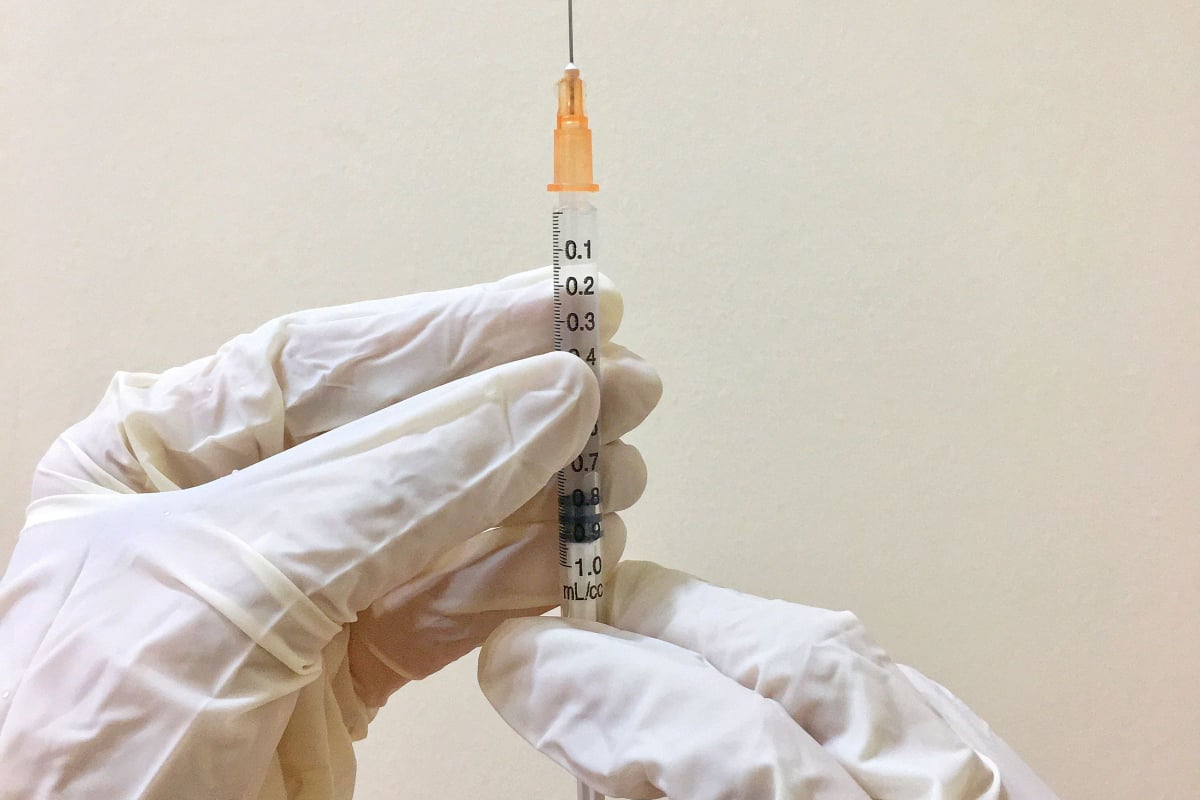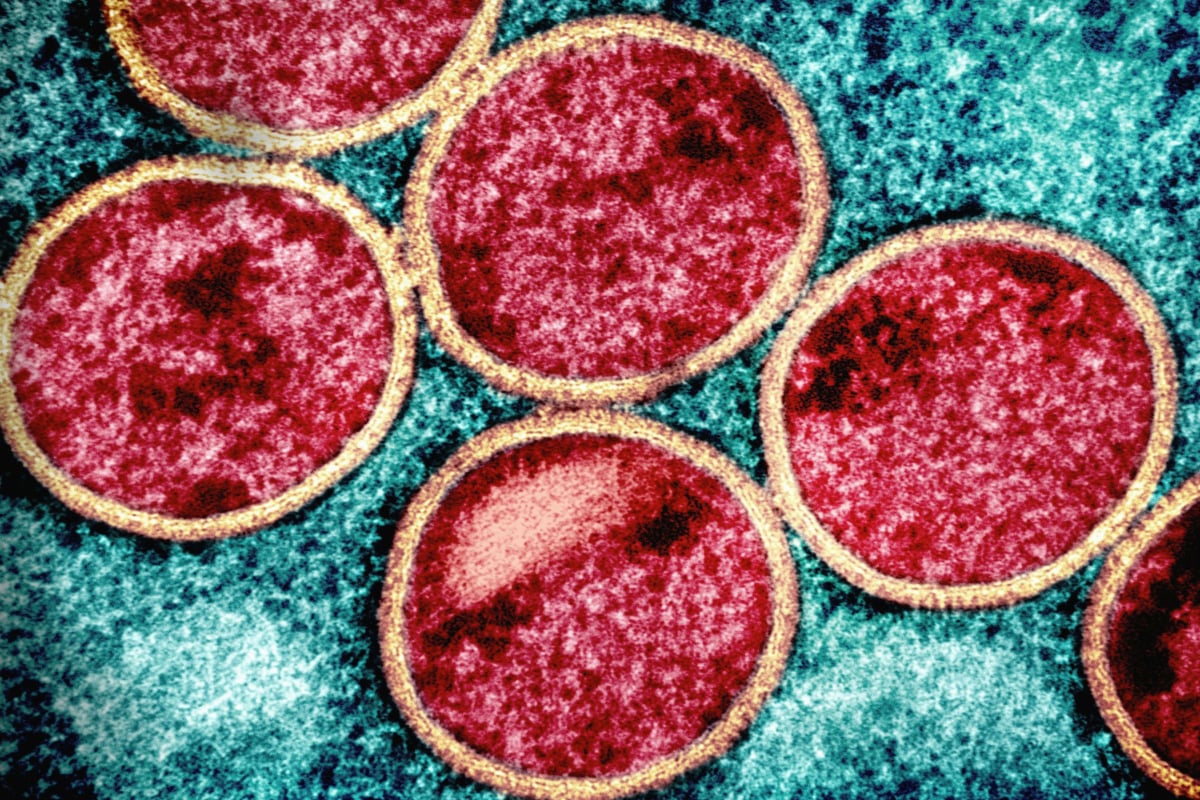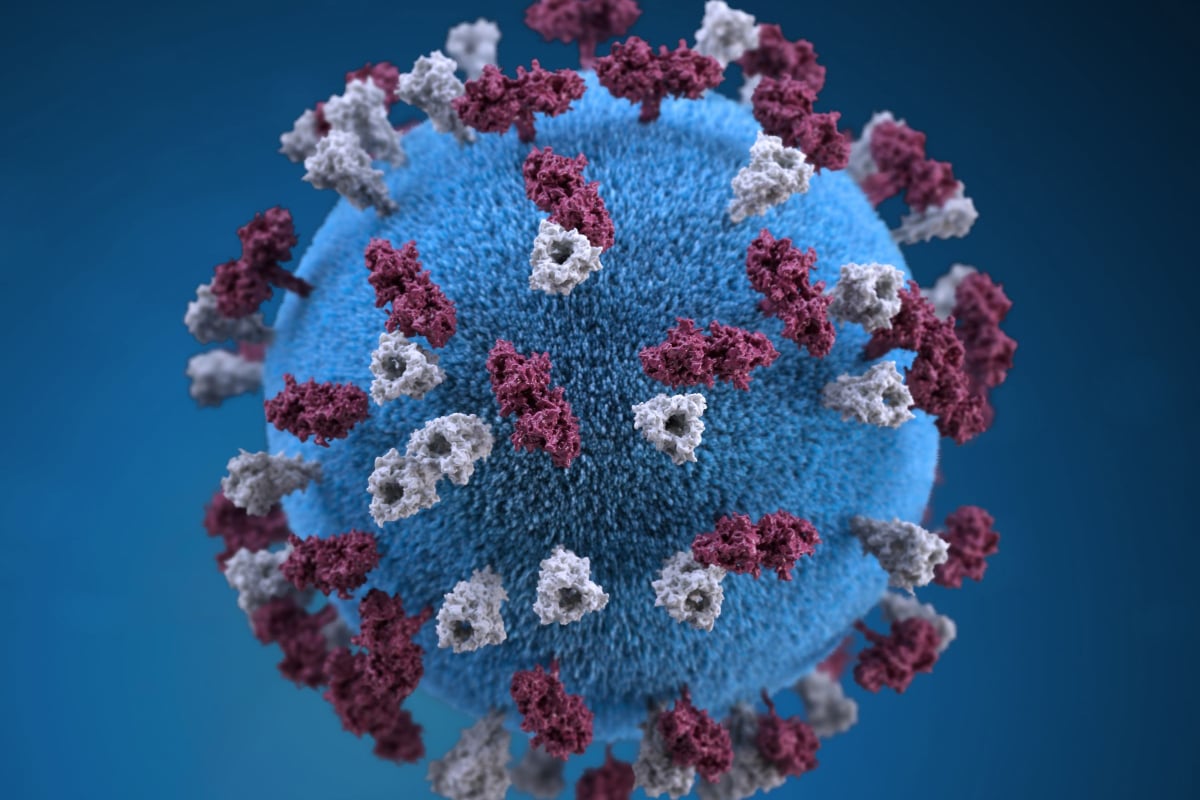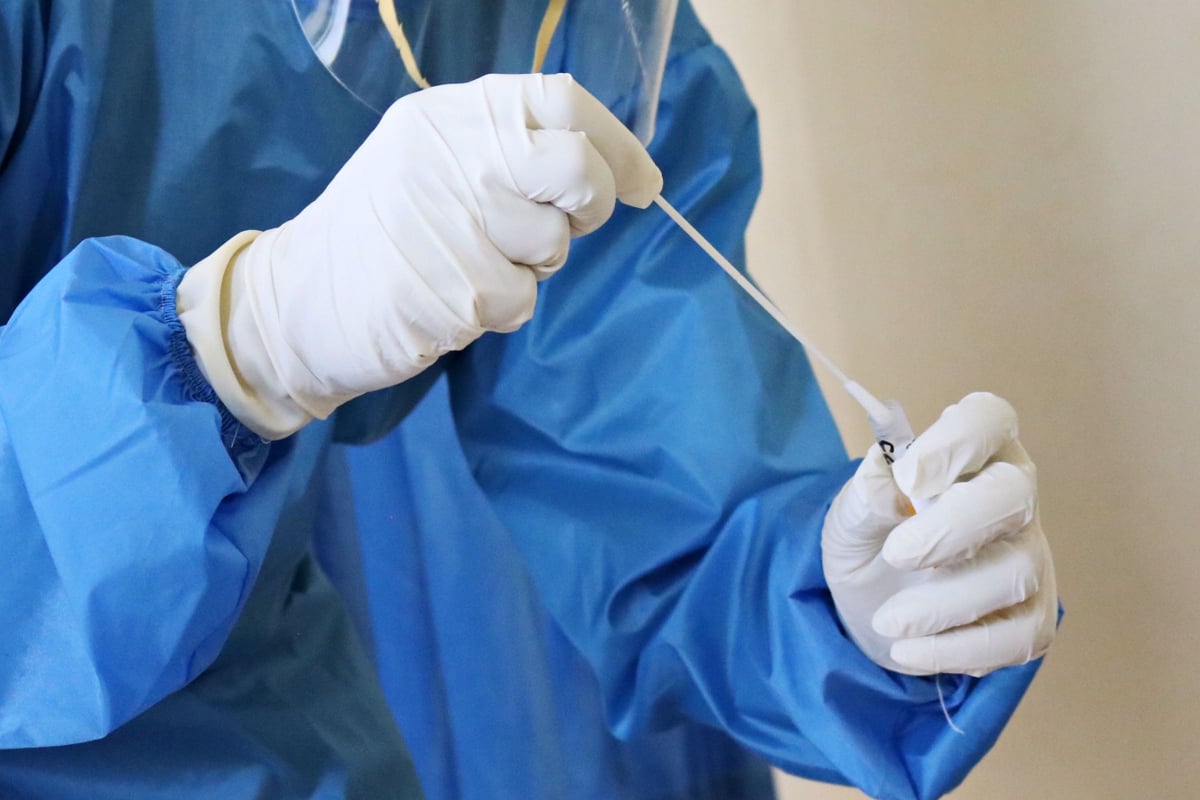Current Health Issues
Measles
Public Health Officials Warn Measles Exposure in Missoula County:
Missoula Public Health was notified that a person infected with measles visited Missoula on Saturday, Nov. 22, 2025. No positive cases of measles have been confirmed in Missoula County at this time.
MPH is aware of three public places the person went while visiting. Measles can stay in the air for up to two hours after an infected person leaves. The listed times include the period when the exposure occurred and two hours after. Anyone who visited the following places on Nov. 22 during these times should monitor for symptoms:
- 11am – 2:30 pm: Missoula TJ Maxx
- 12pm – 3:30 pm: Missoula Scheels
- 1pm – 4 pm: Missoula Old Chicago
MPH says the purpose of notifying the public is not to cause panic or fear, but to encourage those who may have been in these public places to know their vaccination status and monitor for symptoms.
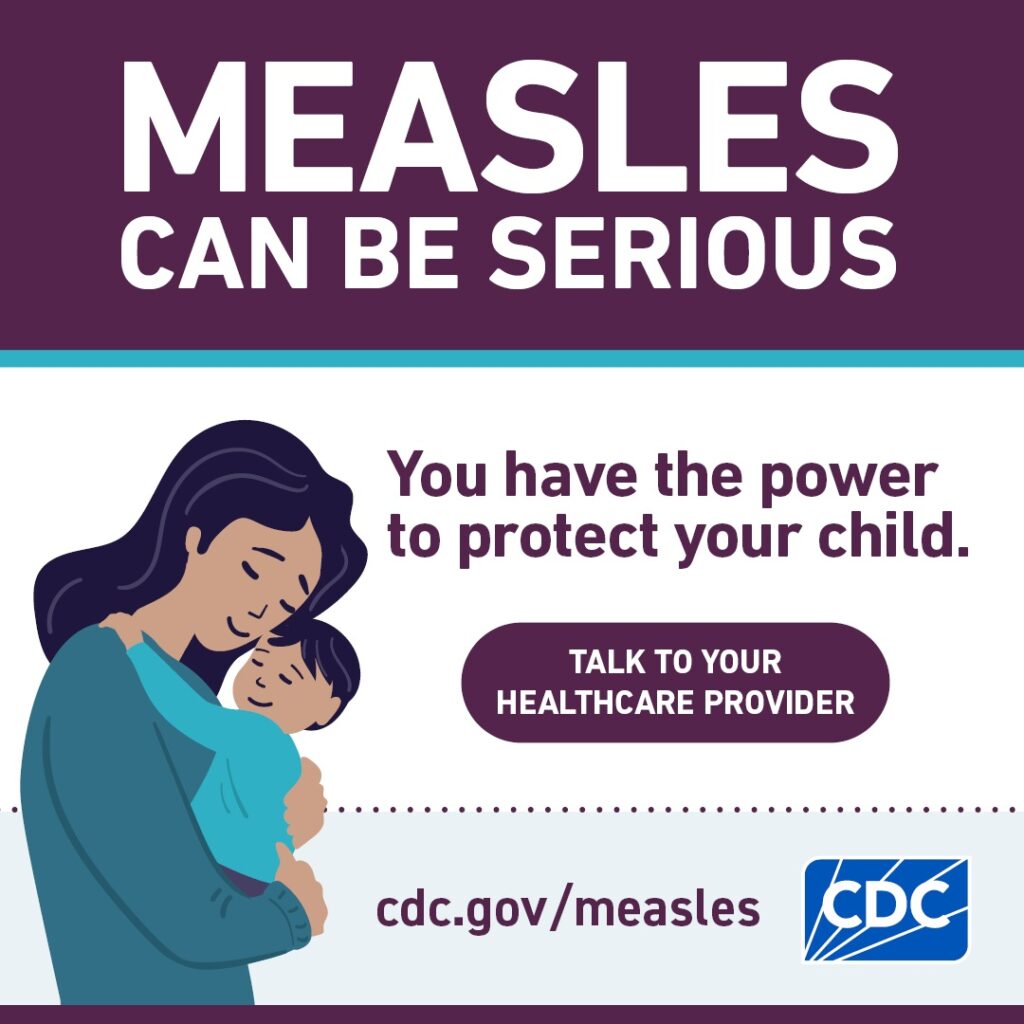
Measles Prevention through MMR Vaccination
The best way to prevent against Measles is to get the measles-mumps-rubella vaccine. (called MMR)
Measles is a serious respiratory disease (in the lungs and breathing tubes) that causes a rash and fever. It is highly contagious.
Doctors recommend that your child get 2 doses of the MMR shot for best protection. Your child will need one dose at each of the following ages:
- 12 through 15 months
- 4 through 6 years
Infants 6 months to 11 months old should have 1 dose of MMR shot before traveling to another country.
Guidance Documents
Frequently Asked Questions
How do I protect myself from measles?
Am I protected against measles?
CDC considers you protected from measles if you have written documentation (records) showing at least one of the following:
- You received two doses of measles-containing vaccine, and you are a(n)—
- school-aged child (grades K-12)
- adult who will be in a setting that poses a high risk for measles transmission, including students at post-high school education institutions, healthcare personnel, and international travelers
- You received one dose of measles-containing vaccine, and you are a(n)—
- preschool-aged child
- adult who will not be in a high-risk setting for measles transmission
- A laboratory confirmation that you had measles at some point in your life
- A laboratory confirmation that you are immune to measles
- You were born before 1957
What should I do if I’m unsure whether I’m immune to measles?
If you’re unsure whether you’re immune to measles, you should first try to find your vaccination records or documentation of measles immunity. If you do not have written documentation of measles immunity, you should get vaccinated with measles-mumps-rubella (MMR) vaccine. Another option is to have a doctor test your blood to determine whether you’re immune. But this option is likely to cost more and will take two doctor’s visits. There is no harm in getting another dose of MMR vaccine if you may already be immune to measles (or mumps or rubella).
I’ve been exposed to or may have measles. What should I do?
I’ve been exposed to someone who has measles. What should I do?
Immediately call your doctor and let them know that you have been exposed to someone who has measles. Your doctor can:
- determine if you are immune to measles based on your vaccination record, age, or laboratory evidence, and
- make special arrangements to evaluate you, if needed, without putting other patients and medical office staff at risk.
If you are not immune to measles, MMR vaccine or a medicine called immune globulin may help reduce your risk developing measles. Your doctor can help to advise you and monitor for signs and symptoms of measles.
If you do not get MMR or immune globulin, you should stay away from settings where there are susceptible people (such as school, hospital, or childcare) until your doctor and health department says it’s okay to return. This will help ensure that you do not spread it to others.
I think I have measles. What should I do?
Immediately call your doctor and let them know about your symptoms you are having. Your doctor can:
- determine if you are immune to measles based on your vaccination record or if you had measles in the past, and
- make special arrangements to evaluate you, if needed, without putting other patients and medical office staff at risk.
My doctor or someone from the health department told me that I have measles. What should I do?
If you have measles, you should stay home for four days after you develop the rash. Staying home is an important way to not spread measles to other people. Talk to your doctor to discuss when it is safe to return.
You should also:
- Cover your mouth and nose with a tissue when you cough or sneeze and put your used tissue in the trash can. If you don’t have a tissue, cough or sneeze into your upper sleeve or elbow, not your hands.
- Wash your hands often with soap and water.
- Avoid sharing drinks or eating utensils.
- Disinfect frequently touched surfaces, such as toys, doorknobs, tables, counters.
Call your doctor if you are concerned about your symptoms.
What is quarantine?
Quarantine is for non-immune people who have been in contact with someone with measles. It is an important part of stopping measles spreading in the community, especially to high risk people. Quarantine means staying at home and away from daycare/school/work, group and social activities, sports and recreation events and public places like cinemas and shopping malls.
Who needs to be quarantined?
People who are not immune and have been exposed to someone with measles and are in the period where they could still get sick from it.
Why is the quarantine period for measles 21 days?
Although the incubation period (time between being exposed to the measles virus and the appearance of the first symptoms) is usually 10-14 days, sometimes it can take longer from the time someone is exposed to measles until the time they get sick from it. We begin quarantine from 5 days after first exposure and through 21 days after your last exposure. Quarantine should only occur in consultation with public health authorities, who will be able to help you determine the appropriate dates for quarantine. A nurse from Missoula Public Health will be in direct contact with you if you fit the criteria necessitating quarantine.
If I get the vaccine now, will the quarantine be shorter?
If you were able to receive the vaccine within 72 hours after first exposure to someone with measles, you might not need to be quarantined. However, if you receive the vaccine after 72 hours, you will need to be quarantined for 21 days. A nurse from Missoula Public Health will assess your specific situation and exposure period to determine how long you will need to be quarantined.
Do household members of a quarantined person need to be vaccinated?
See above: “How do you know if someone is immune to measles?” Household members who are immune to measles do not need vaccine. Household members who are not immune, or are not sure whether they are immune, should consider getting vaccine.
Can anyone come into the house where a person is quarantined?
No. Entering the home where a person is quarantined is highly discouraged. However, in cases requiring caregivers such as a child or the elderly, some individuals will be allowed to enter the household.
Documentation of birth before 1957, two valid measles vaccine doses, or a blood test showing measles immunity will need to be seen by Public Health officials for persons wanting to enter the quarantined home. No others will be allowed to enter.
If I have been exposed to measles, can I spread it to others in my household while I am under quarantine?
If you do not get measles, you cannot spread it to others. However, because you are still in the period where you could become ill, you may not know you are infectious. You can spread the disease up to 4 days before you develop a rash. Therefore, it is best to limit contact with those in your household and they should review their immune status. Please see above: “How do you know if someone is immune to measles?”.
Can the measles virus be transmitted via clothing?
No, measles cannot be spread via clothing.
When an infected person talks, coughs or sneezes, the virus is released into the air and enters another person’s body through the nose, mouth or throat. People can also become sick if they come in direct contact with the mucus or saliva (spit) from an infected person. Also, measles virus can live for up to two hours on a surface or in an airspace where the infected person coughed or sneezed. If other people breathe the contaminated air or touch the infected surface, then touch their eyes, noses, or mouths, they can become infected. A person who is not infected with the measles virus cannot transmit the virus to others or bring it home to family members and friends.
What about handwashing? Wearing a mask?
It is important for people to wash their hands frequently with soap and water, especially after coughing, sneezing, blowing their nose, going to the bathroom, or having contact with moist materials such as tissues, diapers, and used masks. A minimum of 60% alcohol-based hand sanitizer can also be used instead of soap and water if the hands are not visibly dirty.
If there are other individuals living in the home of the quarantined person who are not immune to measles, the likelihood that they will get sick with measles may be reduced if the quarantined person stays inside their designated room/area, avoids contact with others, and wears a mask when in common rooms.
Does the quarantined person need to wear a mask when leaving the house?
The quarantined person should not leave the house, except to receive emergency medical care. In this case, yes, the quarantined person should wear a mask. If the quarantined person will not be able to wear the mask at all times because they are a baby or a child, this should be discussed with the medical facility before arrival.
Can pets get infected with measles or spread measles?
No, pets do not get infected with or spread the measles virus.
What should I do if I get sick?
If you become ill with measles-like symptoms, including fever, rash, runny nose, cough, loss of appetite, and “pink eye”, seek medical attention but remember to call your health care provider before going to the medical office and inform them that you were exposed to someone with measles or that you have symptoms of measles so that special arrangements can be made to prevent exposure to other patients and medical office staff. You should not go to work or school if you are sick.
I have questions about the measles vaccine:
How effective is the measles vaccine?
The measles vaccine is very effective. One dose of measles vaccine is about 93% effective at preventing measles if exposed to the virus. Two doses are about 97% effective.
How safe is the measles vaccine?
The MMR vaccine is a safe vaccine. CDC and the Food and Drug Administration (FDA) are committed to ensuring that vaccines provided to the public are safe and effective. Once vaccines are licensed or authorized for emergency use in the United States, CDC and FDA continuously monitor them through several safety systems.
Are there side effects to the vaccine?
Common side effects include fever and soreness at the injection site. Some people may experience a mild rash and swollen glands in the neck or cheeks.
As with any medication, there can be adverse effects associated with the MMR vaccine. While very rare, these could include severe allergic reaction following vaccination, increased risk of febrile seizures, temporary low platelet count, and temporary pain or stiffness in joints (mostly in teenage or adult women without prior immunity to rubella).
Does the MMR Vaccine cause autism?
No. Because signs of autism may appear around the same time children receive the MMR vaccine, some parents may worry that the vaccine causes autism. Vaccine safety experts, including experts at the American Academy of Pediatrics (AAP), agree that MMR vaccine is not responsible for recent increases in the number of children with autism. In 2004, a report by the Institute of Medicine (IOM) concluded that there is no link between autism and MMR vaccine, and that there is no link between autism and vaccines that contain thimerosal as a preservative. There have been many carefully performed scientific studies since then that have found no link between the MMR vaccine and autism.
Could I still get measles if I am fully vaccinated?
Very few people—about three out of 100—who get two doses of measles vaccine will still get measles if exposed to the virus. Experts aren’t sure why. It could be that their immune systems didn’t respond as well as they should have to the vaccine. But the good news is, fully vaccinated people who get measles are much more likely to have a milder illness. And fully vaccinated people are also less likely to spread the disease to other people, including people who can’t get vaccinated because they are too young or have weakened immune systems.
Do I ever need a booster vaccine for measles?
No. CDC considers people who received two doses of measles vaccine as children according to the U.S. vaccination schedule protected for life, and they do not ever need a booster dose.
Adults need at least one dose of measles vaccine, unless they have evidence of immunity. Adults who are going to be in a setting that poses a high risk for measles transmission should make sure they have had two doses separated by at least 28 days. These adults include students at post-high school education institutions, healthcare personnel, and international travelers.
If you’re not sure whether you were vaccinated, talk with your doctor.
How dangerous is measles?
Measles is one of the most contagious diseases.
Measles will infect up to 9 out of 10 susceptible people who have close contact to a person with measles.
Measles is spread in the air when an infected person breathes, coughs, or sneezes. These germs can stay in the air for up to 2 hours after the infected person leaves an area.
What are the symptoms of measles?
Measles causes high fever, tiredness, muscle pain, sore throat, headache, cough, runny nose, red, itchy eyes, and a rash. Sometimes people get Koplik’s spots (red spots with white centers) in the mouth.
What are the complications of measles?
- Measles can also cause other infections such as pneumonia, ear infections or diarrhea.
- 1 out of every 1,000 measles cases will develop acute encephalitis (swelling of the brain), which often results in permanent brain damage.
- 1 to 3 out of every 1,000 children who become infected with measles will die from respiratory and neurologic complications.
- Measles can cause Subacute Sclerosing Panencephalitis (SSPE) which is a rare, but fatal nervous system infection that happens years after a measles infection.
- Measles can cause immune amnesia in unvaccinated individuals. This is basically a hard reset of the immune system after being infected with the measles virus. This dangerous process puts people at risk of developing other infections that they would have previously been able to fight because their immune memory cells have been erased. This immune amnesia can last for months to years (2-3 years or longer). Vaccination with the MMR is the best way to prevent measles and the associated immune amnesia.
- If you are pregnant, in addition to making you sick, measles can cause preterm labor, low birth weight, or miscarriage.
- Measles can result in death.
MMR vaccine is the safest way to protect yourself from measles.
What is the treatment for measles?
Is there a cure or treatment for measles?
There is no cure for measles. Care focuses on relieving symptoms and addressing medical complications that may arise.
What about Vitamin A supplementation?
In resource-limited countries, where malnutrition is more common, Vitamin A supplementation may play a role in reducing the morality associated with measles. In hospitalized patients with measles, a licensed healthcare provider may consider Vitamin A supplementation though benefits are unknown in well-nourished populations. It is important to know that Vitamin A does not prevent measles or stop the spread of measles. Vitamin A should not be considered a replacement for vaccination. If taken incorrectly, Vitamin A can have serious side effects such as toxicity or liver damage.
MMR vaccine is the safest way to protect yourself from measles.
What is the history of measles in the United States?
How common was measles in the United States before the vaccine?
Before the measles vaccination program started in 1963, about 3 to 4 million people got measles each year in the United States. Of those people, 400 to 500 died, 48,000 were hospitalized, and 4,000 developed encephalitis (brain swelling) from measles.
What are the vaccine coverage levels like in the United States?
Nationally, the rates of people vaccinated against measles have been very stable since the Vaccines for Children (VFC) program began in 1994. For 2022-2023 school year, nationwide vaccination coverage of kindergarten children with MMR is 93.1%. However, MMR vaccination coverage levels continue to vary by state, with MMR coverage levels of <90% observed in 12 states and local areas during the same time period. At the county or lower levels, vaccine coverage rates may vary considerably. Pockets of unvaccinated people can exist in states with high vaccination coverage, underscoring considerable measles susceptibility at some local levels.
Is measles a concern for the United States?
Yes. Since measles is still common in many countries, travelers will continue to bring this disease into the United States. Measles is highly contagious, so anyone who is not protected against measles is at risk of getting the disease. People who are unvaccinated for any reason, including those who refuse vaccination, risk getting infected with measles and spreading it to others. And they may spread measles to people who cannot get vaccinated because they are too young or have specific health conditions.
Why have there been more measles cases in the United States in recent years?
In 2011, 2014, 2018, and 2019, states reported higher numbers of measles cases compares to other years post-elimination. Since December 2023, the US has seen a large increase in cases, with more cases already reported in 2024 than all of 2023. CDC experts attribute this to:
- More measles cases than usual in countries to which Americans often travel (such as the United Kingdom, Austria, and the Philippines), and therefore more measles cases coming into the U.S., and/or
- More spread of measles in U.S. communities with pockets of unvaccinated people
Could measles ever re-establish itself in the United States?
Yes, measles could become endemic (constant presence of a disease in an area) in the United States again, especially if vaccine coverage levels drop. This can happen when people;
- forget to get vaccinated on time,
- don’t know that they need a vaccine dose (this is most common among adults), or
- refuse vaccines for religious, philosophical or personal reasons.
Research shows that people who refuse vaccines tend to group together in communities. When measles gets into communities with pockets of unvaccinated people, outbreaks are more likely to occur. It can be difficult to control the spread of the disease in these communities, which could lead to the virus re-establishing itself in the United States.
High sustained measles vaccine coverage and rapid public health response are critical for preventing and controlling measles cases and outbreaks.
Where do cases of measles that are brought into the United States come from?
Unvaccinated travelers can bring measles into the United States from any country where the disease still occurs or where outbreaks are occurring including Europe, Africa, Asia, and the Pacific. In 2022, there were an estimated 9 million measles cases worldwide and 136,000 deaths, mostly children. In recent years, many measles cases came into the United States from common U.S. travel destinations, such as the United Kingdom, Austria, the Philippines, and Romania, that are experiencing outbreaks of measles. CDC has a travel alert related to the global measles situation that can be read on CDC’s Global Measles page.
If measles is eliminated, why do people still get it in the United States?
Every year, unvaccinated travelers (Americans or foreign visitors) get measles while they are in other countries and bring measles into the United States. They can spread measles to other people who are not protected against measles, which sometimes leads to outbreaks. This can occur in communities with unvaccinated people.
Most people in the United States are protected against measles through vaccination, so measles cases in the U.S. are uncommon compared to the number of cases before a vaccine was available. Since 2000, when public health officials declared measles eliminated from the U.S., the annual number of people reported to have measles ranged from a low of 13 people in 2020 to a high of 1274 people in 2019.
Has measles been eliminated from the United States?
Yes. In 2000, the United States declared that measles was eliminated from this country. The United States eliminated measles because it has a highly effective measles vaccine, a strong vaccination program that achieves high vaccine coverage in children, and a strong public health system for detecting and responding to measles cases and outbreaks.
What does “measles elimination” mean?
CDC defines measles elimination as the absence of continuous disease transmission for 12 months or more in a specific geographic area. Measles is no longer endemic (constantly present) in the United States.
Will the United States ever get rid of measles completely?
Yes, it’s possible. The first step is to eliminate measles from each country and region of the world. Once this happens, there will be no place from which measles can spread.
All member states in the six World Health Organizations regions have committed to eliminating measles, however progress slowed during the COVID-19 pandemic. The current goal is complete elimination by 2030. Once every country eliminates a disease, health officials consider the disease “eradicated” from the world.
Resources:
Immunize.org: www.immunize.org
National Foundation for Infectious Diseases: www.nfid.org/measles
Vaccinate Your Family: https://vaccinateyourfamily.org/measles/
Let’s Get Real About Vaccines: https://www.letsgetrealaboutvaccines.org/learn-about-childrens-vaccines/vaccine-preventable-diseases/measles
Centers for Disease Control and Prevention: www.cdc.gov/measles
Highly Pathogenic Avian Influenza (Bird Flu)
At this time, Highly Pathogenic Avian Influenza (HPAI) or bird flu has not been detected among humans in Missoula County. The infectious disease team at Missoula Public Health continues to monitor the bird flu situation in our community.
What should I do if I find a dead bird?
While the risk is low, wild birds can be infected with avian influenza or HPAI. They may not necessarily show signs of illness. Illness may be spread from an infected bird while migrating and potentially expose domestic poultry to the virus. https://www.aphis.usda.gov/livestock-poultry-disease/avian/avian-influenza/hpai-detections/wild-birds
What to do if I find a dead bird:
- Do not handle with out some sort of personal protective covering: gloves or plastic bag. Something to prevent you from coming into direct contact with the bird and can possibly be disposed of after.
- Place dead bird in a bag or plastic container that can be sealed.
- Wash hands thoroughly with soap and water.
- Contact non-game wildlife biologists at Fish, Wildlife, & Parks at 406.381.2339. They can provide guidance on if they can accept the carcass for testing. Including collecting the bird from location. They may opt not to test.
* If FWP is unable/unwilling to assist with testing and collection, PPE should be worn by the individual (including goggles, gloves, and a mask) and they should double bag and discard the carcass while disturbing it as little as possible. Hand washing with soap and water and removing and washing the clothes they wore during the collection, is also highly recommended. More specific guidance can be found here.
FWP also usually provides direct guidance on how to handle and dispose of the bird if it cannot be collected.
If the individual does have to handle a dead bird, it is recommended for that individual to self-monitor for fever for 10 days after the exposure, notify your provider and public health.
If you have a personal domestic animal that has had exposure please contact a veterinarian and speak to them regarding exposure and animal health concerns.
MPOX
MPOX is a virus in the same family of viruses as smallpox and cowpox. MPOX infections are rare. Anyone can get MPOX. It is not an STI. If you have recently experienced an unexplained rash, please get assessed by your primary care physician.
For the latest information about MPOX, please visit the CDC’s website.
Frequently Asked Questions
What are the symptoms?
The key symptom of MPOX is a rash that can look like pimples or blisters. This rash can appear on any part of the body, including:
- Face, including inside the mouth
- Hands and Feet
- Chest
- Genitals
The rash can include small or large lesions. The lesions are often filled with pus and scab over as they start to heal. These lesions are often painful.
Other symptoms of MPOX include:
- Fever
- Headache
- Muscle aches and backache
- Chills
- Exhaustion
- Swollen lymph nodes
- Cough or sore throat
Symptoms usually appear 5-21 days after exposure. The illness typically lasts 2-4 weeks. MPOX rarely results in death or hospitalization, though hospitalization may be used for pain management. People who are immunocompromised may be more likely to get seriously ill.
How does MPOX spread?
MPOX can spread in different ways. The most common is direct contact with an infectious rash. MPOX can also spread through body fluids and respiratory droplets and secretions, typically through prolonged close contact, such as kissing, cuddling, or sex with an infected person. It can also spread through touching items such as bedding, towels, or clothing that have come in contact with the infectious rash or body fluids. Although rare in the US, it is also possible to get MPOX from infected animals.
What can I do to lower my risk of getting MPOX?
While MPOX is rare and the current threat is low, there are some things you can do to lower your risk:
- Avoid close contact with people who have MPOX symptoms, including face-to-face contact, touching, and sex.
- Practice good handwashing.
- Avoid contact with animals or materials like bedding, towels, and clothing that may have been exposed to MPOX.
- Limiting your number of sexual partners and avoiding anonymous sex can lower your risk.
I think I have MPOX, what should I do?
Contact your primary care provider right away to get tested. If you don’t have a primary care provider or are having trouble getting testing call our disease intervention specialists at 406-258-3896 to be connected to services.
If you test positive:
If you test positive for MPOX, Missoula Public Health (MPH) will reach out to you with specific isolation guidance. Isolate from your ENTIRE household, including pets, until MPH reaches out to you. CDC data suggest people can spread MPOX from the time symptoms start until all symptoms have resolved, including full healing of the rash with formation of a fresh layer of skin. The CDC says, ideally, people with MPOX would remain in isolation for the duration of illness, which typically lasts two to four weeks.
MPOX usually lasts 2 to 4 weeks and resolves without treatment. An antiviral such as tecovirimat (TPOXX) may be recommended depending on the severity of the illness. Please contact your primary care provider if you are interested in TPOXX.
If you’ve been exposed to MPOX:
Missoula Public Health will reach out to you with specific guidance. In the meantime, close contacts of MPOX cases should monitor their health for 21 days after their last exposure. This includes taking their temperature at morning and night and checking for other symptoms of MPOX. If symptoms develop, individuals will need to isolate themselves from others.
Can I get a vaccine?
The Advisory Committee on Immunization Practices (ACIP) recommends the 2-dose JYNNEOS series to several populations and for different indications. Please call 406-258-3363 or stop by the Missoula Immunization Clinic at 301 W. Alder to discuss your questions with a nurse.
- For pre-exposure vaccination of people at risk for occupational exposure to orthopoxviruses (as an alternative to ACAM2000)
- For people aged 18 years and older at risk of mpox during an mpox outbreak:
- CDC has determined that ongoing human-to-human transmission of clade I MPXV in Central and East Africa meets the criteria to be considered an outbreak and is issuing recommendations for vaccine use among travelers at increased risk of mpox exposure who are planning to travel to those specific countries.
- Travelers to affected countries who anticipate the following activities should be offered vaccination with the 2-dose JYNNEOS series: sex with a new partner; sex at a commercial sex venue (e.g., sex club or bathhouse); sex in exchange for money, good, drugs, or other trade; or sex in association with a large public event (e.g., rave, party, or festival).
- For people aged 18 years and older with the following risks:
- Gay, bisexual, and other men who have sex with men, transgender or nonbinary people who in the past 6 months have had one of the following: a new diagnosis of ≥1 sexually transmitted disease; more than one sex partner; sex at a commercial sex venue; or sex in association with a large public event in a geographic area where mpox transmission is occurring
- Sexual partners of people with the risks described above
- People who anticipate experiencing any of the above
Currently, CDC does not recommend routine immunization against mpox for the general public. JYNNEOS is not recommended as a routine vaccination for healthcare personnel unless sexual risk factors are present.
Preparing for Emergencies
Our Public Health Emergency Preparedness Coordinators work with the Office of Emergency Management and many community partners to prepare and respond when emergencies impact our community.
Emergency preparedness begins with you! What is your plan for when disaster strikes? Check out these resources to get started:
Build a Kit
Make a Plan
Everyone has different needs when it comes to sheltering, evacuating, and communicating during an emergency. Talk with your household and support system about:
- What would you need to shelter in place? What would you need if there is no power?
- If you needed to evacuated, what needs would you have? What transportation would you use? Where would you go? How would you meet the needs of your pets and livestock?
- You may not be in the same place as all of your family members when disaster strikes. Make a communication and reunification plan for your family.
Stay Informed
Timely and accurate information is essential during an emergency. To receive local alerts, sign up for Smart911. Check city and county websites and social media platforms.
